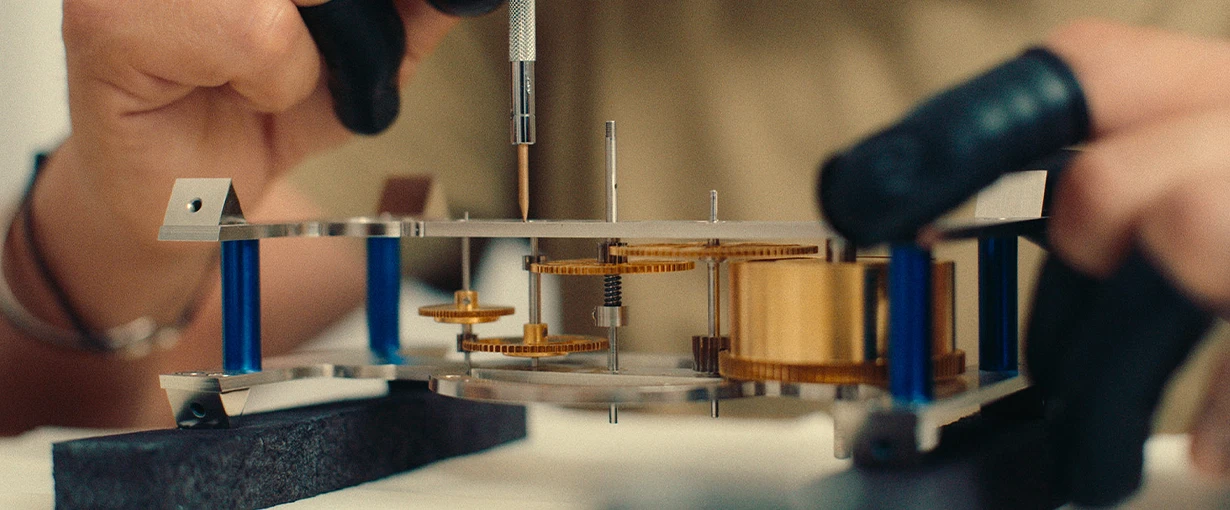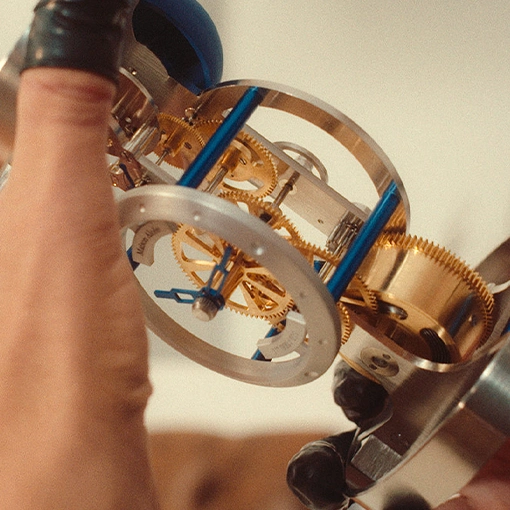The movement
watchmaker of Maison Alcée
A mechanical watchmaking movement thought out and elaborated
exclusively for Maison Alcée to be assembled
by any curious person
A movement
Manufactured watchmaker
The beating heart of Maison Alcée is the watch movementwhich powers the Persée timepiece.This mechanical movement has been designed by a team of watchmaking experts exclusively for Maison Alcée so that it can come to life in the hands of every lover of fine watchmaking. It embodies the result of meticulous work and many years of in-depth research.
The watch movement
Maison Alcée’s know-how
We have created a watch movement that has been developed by our Maison to be magnified by your hands.Our in-house mechanical movement has been designed with one of the Best Craftsmen of France in watchmaking,Thierry Ducret and Jean-Marie Desgranges, both teachers of watchmaking at the prestigious school of Morteau in the Jura.
Thanks to its educational approach, this team has made it possible to transmit watchmaking know-how
and understanding mechanical motion.
Antoine Tschumi, watch designer, has added a new aesthetic touch, in the face of a product that can be perceived as obsolete, the clock.
A nod to the traditional hourglass in the vertical position or to a more modern version in the horizontal position,Persée will have a special place in your home.
“We have to break this vision that certain know-how is inaccessible. It is by taking them out of their seraglio that they will find a new lease of life, that a wider public will see them in a new light. »
You will assemble the mechanical movement entirely, only the regulating organ is pre-assembled.
The Maison Alcée watch movement is similar to that of a wristwatch,
but with larger dimensions.
This will make assembly easier and a better understanding of how the mechanical movement works.
The Maison Alcée timepiece has a power reserve of 14 days,
which means that this watch movement is hand-wound.
You will therefore have to wind your desk watch every 14 days.
Whether you are an unbeatable collector, an unrepentant enthusiast or an insatiable neophyte,
each one becomes for a moment the heir of secular disciplines and sees,
finally, to bring to the surface this pride of having made with his hands.
A movement
Apparent watchmaker
To contemplate your desk watch
The beating heart of your timepiece, the so-called “skeleton” watch movement, is proudly revealed, offering a captivating view of mechanical art in action.
You will admire all the mechanical complexity.
But above all, you will understand how the barrel
and its spring provide the mechanical energy necessary for the movement of each timepiece.
You will discover how this essential component stores and transmits energy to the rest of the movement.
Every gear, every oscillation, every minute interaction between the components is on display, turning every look at your clock into a true educational experience.
The beating heart of your timepiece, the so-called "skeleton" watch movement, is proudly revealed, offering a captivating view of mechanical art in action.
You will admire all the mechanical complexity.
But above all, you will understand how the barrel and its spring provide the mechanical energy necessary for the movement of each timepiece.
You will discover how this essential component stores and transmits energy to the rest of the movement.
Every gear, every oscillation, every minute interaction between the components is on display, turning every look at your clock into a true educational experience.
Characteristics of the watch movement
Oscillator: balance spring
Complication: striking at the passage of the hours can be activated or deactivated
Caliber: Maison Alcée manufacture
Functions: hour, minute and second.
Hand-wound watch movement
Power reserve: two weeks
One-way winding key
Barrel: spring-loaded as for wristwatches
233 components including 169 to be assembled
11 jewels
A baguette-style watch movement
Designed for you
The baguette movement is a marvel of watchmaking engineering.
The linear, wand-like arrangement of the components reveals every interaction between the parts. This configuration provides a unique view of how the different components interact and synchronize to ensure the precise movement of the hands.
Every enthusiast will be able to understand the complexity of watchmaking mechanics thanks to the Maison Alcée hand-wound calibre.
He will then be able to exchange with other curious people once he has a thorough understanding of his assembly.
The baguette movement is a marvel of watchmaking engineering.
The linear, wand-like arrangement of the components reveals every interaction between the parts.
This configuration provides a unique view of how the different components interact and synchronize to ensure the precise movement of the hands.
Every enthusiast will be able to understand the complexity of watchmaking mechanics thanks to the Maison Alcée hand-wound calibre.
He will then be able to exchange with other curious people once he has a thorough understanding of his assembly.
Understand the transmission organ
Transmission on mechanical pendulette movement
The transmission component consists of a series of gear-based mobiles, i.e. wheels and pinions with teeth, whose role is to transmit energy from the spring barrel to the escape wheel while multiplying the rotational speed.
With each increase in speed, the torque (force or rotational force applied to an axis) will decrease.
In watchmaking, each mobile, consisting of a steel pinion and brass wheel assembly, has a name of its own.
Calibre and movement: what is the difference?
The term ‘calibre’ is often equated with that of the movement in watchmaking.
Originally, the word ‘calibre’ simply referred to the dimensions of an object.
Today, in watchmaking, the term “calibre” has transcended its roots, no longer just describing the dimensions of any component, but now encompasses the meticulous design and watchmaking movement of a watch.
The term ‘calibre’ is therefore synonymous with ‘dimension’ in the name of a movement
watchmaker, but the calibre nowadays refers to the movement itself, whether mechanical or quartz.
This term can be very general to designate a watch mechanism as a watch movement, but it is also used as a specific name for a movement in the documentation of certain brands, proof that this word is now anchored as a synonym for “watch movement” in common language.
The main types of movements found in watches are:
- mechanical movements, whether they are hand-wound or self-winding thanks to an oscillating weight.
- quartz movements that are powered by a battery, a source of energy and equipped with a quartz crystal regulator.
Each of these movements embodies a different approach to time and watchmaking know-how.
This term can be very general to designate a watch mechanism as a watch movement, but it is also used as a specific name for a movement in the documentation of some brands, proof that this word is now anchored as a synonym for "watchmaker" in common language.
The main types of movements found in watches are:
- mechanical movements, whether they are hand-wound or self-winding thanks to an oscillating weight.
- quartz movements that are powered by a battery, a source of energy and equipped with a quartz crystal regulator.
Each of these movements embodies a different approach to time and watchmaking know-how.




 French
French English
English